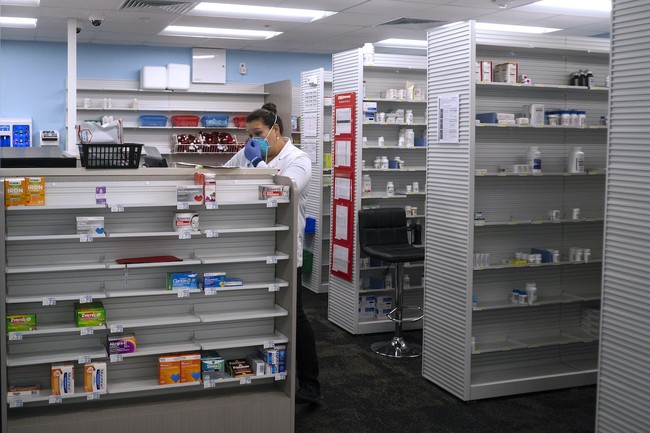
President Trump’s announcement yesterday concerning prescription drug prices was pretty interesting, and sure to start a big debate, as Ed noted in his take apart of it earlier this morning.
Is this a return to Nixonian price controls? Or is this an effort to enforce equitable trade policy and fairness in American markets?
Yes… kinda. Donald Trump announced yesterday that he would sign an executive order that would force drug companies to provide equal pricing for prescription medication between their domestic and international markets, part of a White House effort to seize the high ground on health care. If successful, it could reduce pressure to make cuts to benefits from Medicare and Medicaid, which would make House Republicans happy for the moment. But that’s still a big if, especially when Big Pharma decides to lawyer up.
Trump’s action yesterday is aimed at evening out what the Europeans and others pay and what Americans seem to overpay – about three times the going rate elsewhere on average. Most company profits come from the US.
…Drugmakers have argued that the most favored nation policy would hurt their profits and ultimately, their ability to research and develop new medicines.
White House officials contended that pharmaceutical companies will continue to make money after the price cuts if they realize that the U.S. “alone is not going to pay for innovation” and if they increase prices abroad to get additional revenue there.
Drugmakers “should pursue deals where they get financially rewarded commensurate the value that they are providing to other nations, health systems,” one official said.
“Other countries should pay research and development, too. It’s for their benefit,” Trump added on Monday.
…The industry’s largest trade group, PhRMA, estimated that Trump’s Medicaid proposal could cost drugmakers as much as $1 trillion over a decade.
Some health policy experts have said a most favored nation drug policy may not be effective at lowering medication costs.
For example, USC experts said the policy “can’t undo the basic economics of the global drug marketplace,” where 70% of pharmaceutical profits worldwide come from the U.S.
The USC study found that if it came to deep cuts in US profits while having to sustain weak foreign earnings, the drug companies would more than likely just pull out of the other countries altogether, and saving money here for US consumers would be a wash.
So, what I found intriguing is what Big Pharma, always on their toes as far as the bottom line is concerned, has been doing for the past couple of months that Trump’s been in office.
Pretty much playing both ends against the middle on each side of the Atlantic.
They’ve been telling the EU to straighten their regulatory act up, or they’d leave for the US. The improving business climate and the tariff situation under the Trump administration make doing business in the US much more attractive than dealing with Europe.
Pharma CEOs alert President von der Leyen to risk of exodus to the US
Today, CEOs of the research-based pharmaceutical industry issued a stark warning to President von der Leyen that unless Europe delivers rapid, radical policy change then pharmaceutical research, development and manufacturing is increasingly likely to be directed towards the US.
A survey of EFPIA member companies conducted last week – to which 18 international large and medium-sized innovative companies responded – identified as much as 85% of capital expenditure investments (approximately €50.6 billion) and as much as 50% of R&D expenditure (approximately €52.6 billion) potentially at risk. This is out of a current combined total of €164.8 billion in investments planned for the period 2025-2029 in the EU-27 territory. Over the next three months, companies that responded estimate that a total of €16.5 billion i.e. 10% of the total investment plans is at risk.
The US now leads Europe on every investor metric from availability of capital, intellectual property, speed of approval to rewards for innovation. In addition to the uncertainty created by the threat of tariffs, there is little incentive to invest in the EU and significant drivers to relocate to the US.
The EU is in the end stages of its negotiations for pharmaceutical reforms like its new Critical Medicines Act, and the pressure is on from both the medical community and the pharmaceutical industry to lighten up on the regulations so innovation, manufacturing, and research can be revitalized in the EU itself.
…As EU Health Ministries approach the final stages of negotiations on the future of Europe’s pharmaceutical rules, Medicines for Europe has called for key actions to ensure medicine supply is protected in the region.
They have already begun experiencing supply chain challenges in critical generics, with consolidation exacerbating the problem.
…New analysis from Teva Pharmaceuticals Europe has reported concerning statistics regarding the security of critical medicines supply in the region is at risk. For instance, in the EU, 46 percent of generic medicines from the EU Critical List of Medicines are provided by a single supplier. For these firms with over 60 percent market share, this number rises to 83 percent of critical generic medicines, according to the data.
One industry group, Medicines for Europe, is urging the EU toward specific steps to keep the generic supplies so vital to European health stable.
…As a dedicated partner in the Critical Medicines Alliance, Medicines for Europe would like to advance on:
• A concrete shortage prevention -strategy, with actions to reduce medicines shortages such as EU procurement guidance in tandem with national market reform, that reward security of supply and a greater use of real-time serialisation (EMVS) data to monitor demand and supply imbalances.
• Partnership between the EU and our industry to restore EU manufacturing competitiveness by boosting innovation in production technologies.
• A shared commitment to ensure access, availability and supply security based on EU solidarity. This would strive to achieve equity for critical medicines access between EU countries and replacing competitive national stockpiling mandates with a coherent EU reserve policy.
Speaking at the launch of the Critical Medicines Alliance, Medicines for Europe members outlined our presence in Europe, with production in almost every member state of the Union that can manufacture a wide range of medicines and active ingredients. These medicines are relied on by patients across the continent to manage their condition and to live well. Our hope is to see support for our sector take shape in a dedicated Critical Medicines Act that covers necessary investment in manufacturing technology, market policies that support diversification and supply chain resilience and digital tools and commitments based on EU solidarity to tackles shortage risks.
But, while the industry tries to nudge the Brussels Brahmins into a more conducive business climate in Europe…
Watch: Novartis CEO Vas Narasimhan and Sanofi leader Paul Hudson wrote in Britain’s Financial Times that European price controls and austerity measures reduce the attractiveness of its markets, urging the EU to allow drug prices to rise to US levels https://t.co/dQrMnzS3Ji pic.twitter.com/lDqbUBZqfz
— Reuters Business (@ReutersBiz) April 23, 2025
…they have not hesitated to use the threat of an exit to the US as the cudgel behind the gentle hints.
European pharma companies warned the European Commission president at a meeting on Tuesday that U.S. tariffs would expedite the industry’s shift away from Europe and toward the United States.Pharma trade lobby EFPIA, whose members include European pharma giants Bayer (BAYGn.DE), opens new tab, Novartis (NOVN.S), opens new tab and Novo Nordisk (NOVOb.CO), opens new tab, said it had called on EU President Ursula von der Leyen to push for “rapid and radical action” to mitigate the “risk of exodus” to the United States.…EFPIA said the EU needs to change its regulatory framework for the industry to make it more conducive to innovation and strengthen Europe’s intellectual property provisions.
The demands were not new. EFPIA has repeatedly warned that Europe’s pharma sector will lose out to increased competition from the United States, China and emerging markets if the EU does not amend a proposed revamp of laws governing the sector.
Some of them are already expanding here, and we’ve learned – thanks to recent shortages in generics from China, etc. – that we need to bring that critical capability back.
…Europe and the United States have interconnected supply chains for medicines. The United States depends on medicines partly produced in Europe that bring in hundreds of billions of dollars in revenue.
…European pharma giants have recently been expanding production facilities in the United States.
The United States is the biggest pharma market by sales for big pharma companies, both U.S. and European headquartered ones. Sales in North America accounted for nearly 50% of world pharmaceutical sales in 2021, compared with nearly 25% for Europe, according to EFPIA.
Dutch investment analysts are betting on the US in the pharma wars at the moment.
…Commenting on the Trump administration’s aim to impose tariffs to incentivise the reshoring of pharmaceutical manufacturing, Dutch multinational bank ING said that such tariffs would be a double-edged sword for the EU.
The bank said branded manufacturing could shift from Europe to the US, while the price of generics in Europe could be driven down, lessening any incentives to reshore their production to Europe.
ING Healthcare Economist Diederik Stadig told Euractiv that a response to US tariffs should come from the EU rather than Dick Schoof’s government.
Moreover, ING highlights the plans for increased investments in the US following the threat of tariffs announced by branded pharmaceutical companies.
“J&J was one of these companies, and they also have a production facility in the Netherlands. We don’t think that this will cause a problem for the Dutch facility as they export to Europe as well as the US,” Stadig said, adding, “Rather, this is a broader trend that we believe will strengthen the US position in branded pharma over the coming 5 to 10 years.”
He said that time-to-market for innovative medication and pricing make the US more appealing for branded pharmaceuticals.
“If governments want to incentivise investments in Europe, these are the two levers they could pull,” Stadig said. “There are, of course, enough reasons to want to keep prices low, but this makes Europe less appealing as a destination for investment compared to the US.”
Will more pharmaceutical manufacturing reshoring to the US be the answer to reduced prices, more so than waving a regulatory wand?
Is that where Trump’s actually going with this?
Hard to know because it is never a straight line with that man and what his real objective is.
And you really have to look at what else is swirling around that impacts the end result, even if it seems it has little, if anything, to do with it at the outset.
Kind of like how ‘many balls in the air can you keep track of…plus three more‘ at any given time with this bunch.












